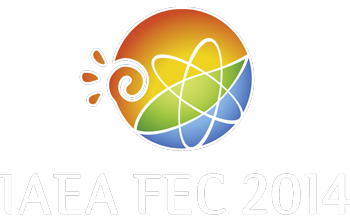Speaker
Dr
Matthias Reich
(Max-Planck-Institut für Plasmaphysik, Garching, Germany)
Description
In high performance plasmas, Neoclassical Tearing Modes (NTMs) are regularly observed at large beta-values. NTMs reduce the achievable normalized beta and degrade the fusion reactor performance which scales as beta_N squared. A widely used method, also foreseen for ITER, for avoiding and controlling NTMs is the deposition of electron cyclotron current drive (ECCD) on the relevant rational surface. ASDEX Upgrade is making a large effort to develop, operate and evaluate an ECCD based, generic solution to MHD control, easily portable to new devices like ITER. A number of real-time diagnostics and intelligent controllers achieve precise control of ECCD deposition inside the O-point, thus minimizing the power required for NTM stabilization.
For robustly operating our feedback loop, proper integration into and coordination of several diagnostic systems with the discharge control system (DCS) was essential, hence a reliable framework was designed, developed and tested. The relevant cooperating diagnostic systems are “Equilibrium”, “ECE/Mirnov” and “rt-TORBEAM” with “ECRH” as the main actuator, centrally coordinated by DCS at timescales faster than typical current diffusion times (AUG: tau approx. 150 ms). All subsystems adhere to cycle times of 15 ms (rt-TORBEAM) or less than 5 ms (all others), such that the full control loop can be executed every 20 ms, making sophisticated experiments possible.
Using the feedback loop, we can reliably target and – provided sufficient ECCD power is applied – stabilize NTMs triggered at beta_N larger than 2. The system can target either 2/1 or 3/2 NTMs, whichever is detected to have the higher amplitude. The amplitude can also be used to refine the target by searching for the deposition location which minimizes the amplitude. To avoid a mode developing at all, preemptive stabilisation can be performed by tracking rational surfaces from a real-time equilibrium.
In our experiments we are developing and testing a variety of control strategies, to preempt and/or stabilize existing NTMs. We have started to integrate ECCD based control of other MHD instabilities, like sawteeth, into the control scheme, thus capitalizing on the generic approach of mapping all relevant information into the same reference coordinate system given by the real-time magnetic equilibrium. This strategy can directly be adopted by next step machines such as ITER.
| Country or International Organisation | Germany |
|---|---|
| Paper Number | PPC/P1-26 |
Author
Dr
Matthias Reich
(Max-Planck-Institut für Plasmaphysik, Garching, Germany)
Co-authors
Dr
Christopher Raspon
(IPP Garching)
Dr
Olivier Sauter
(CRPP Lausanne)
et al. et al.
(IPP Garching)

